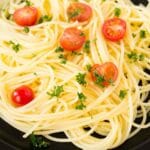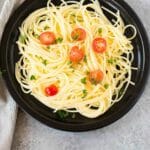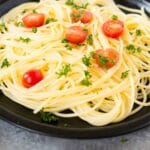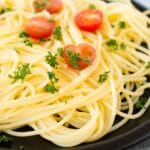This post may contain affiliate links. Read my disclosure page here.
Grab all of my top tips to learn how to cook pasta perfectly every time. A great option for a quick and easy weeknight meal when tossed in a simple homemade sauce, or use cold in pasta salads. This foolproof method guarantees the best results when cooking dried pasta at home.
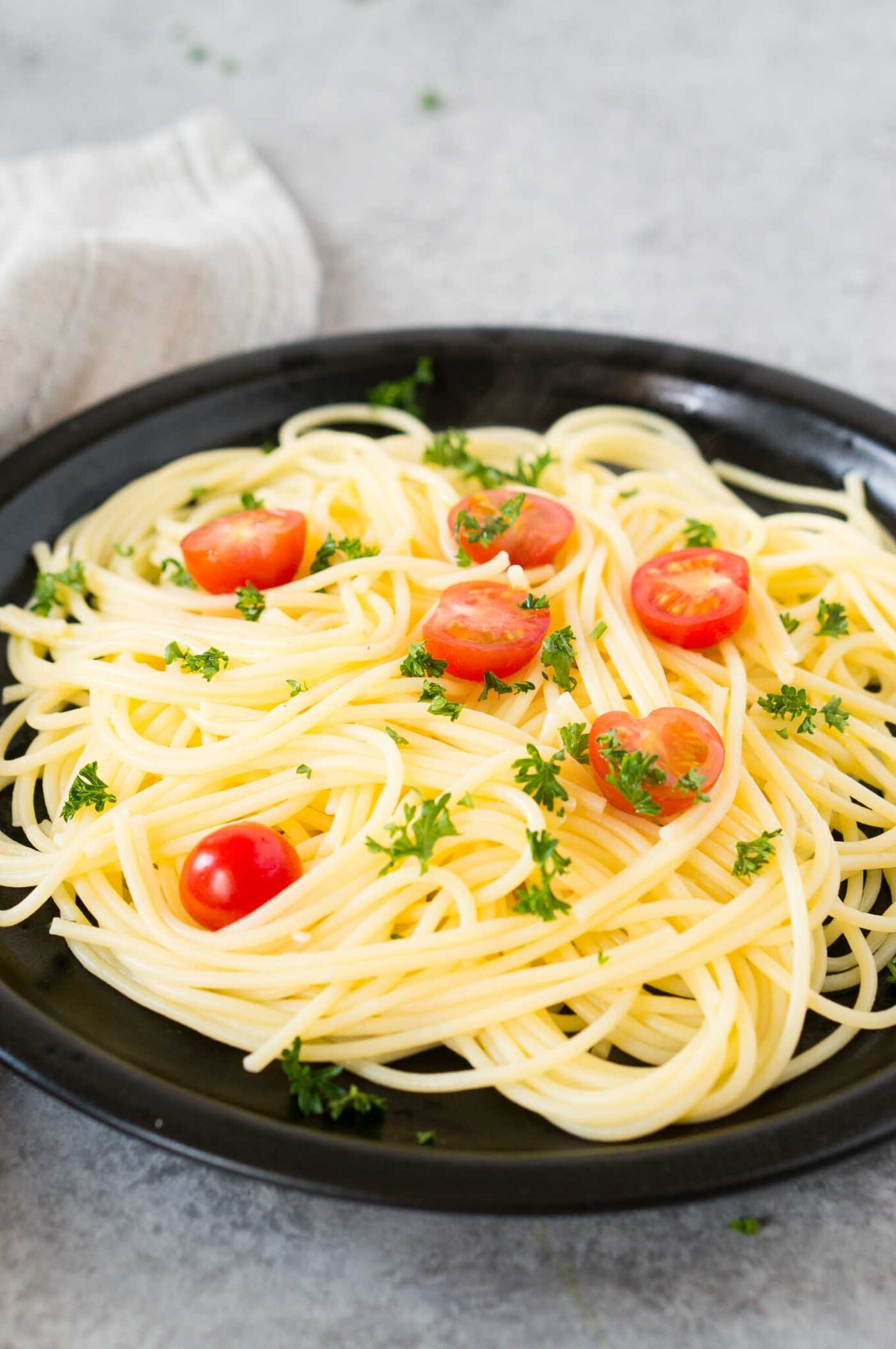
Save This Recipe
Enter your email and we’ll send the recipe directly to you!
By submitting this form, you consent to receive emails from Delicious Meets Healthy.
We have pasta for dinner at least once every other week, and I have a feeling that most families are the same! It’s a perfect go-to for a weeknight dinner when you don’t want to spend hours in the kitchen.
Take the guesswork out of how to cook the perfect pasta with these simple and easy tips. It’s easy when you know how!
Be sure to check out my other tips for cooking basics like How to Cook Couscous and How To Cook Quinoa.
Why you will love this recipe!
- Quick and easy: When you need to get a tasty dinner on the table in minutes, pasta is a great go to!
- Kid friendly: If you have picky eaters in your house, then pasta is a great option! Toss it in their favorite sauce and you are good to go!
- Budget-friendly: Dried pasta is an affordable kitchen staple. It’s satisfying and is a great addition to a well-balanced diet.
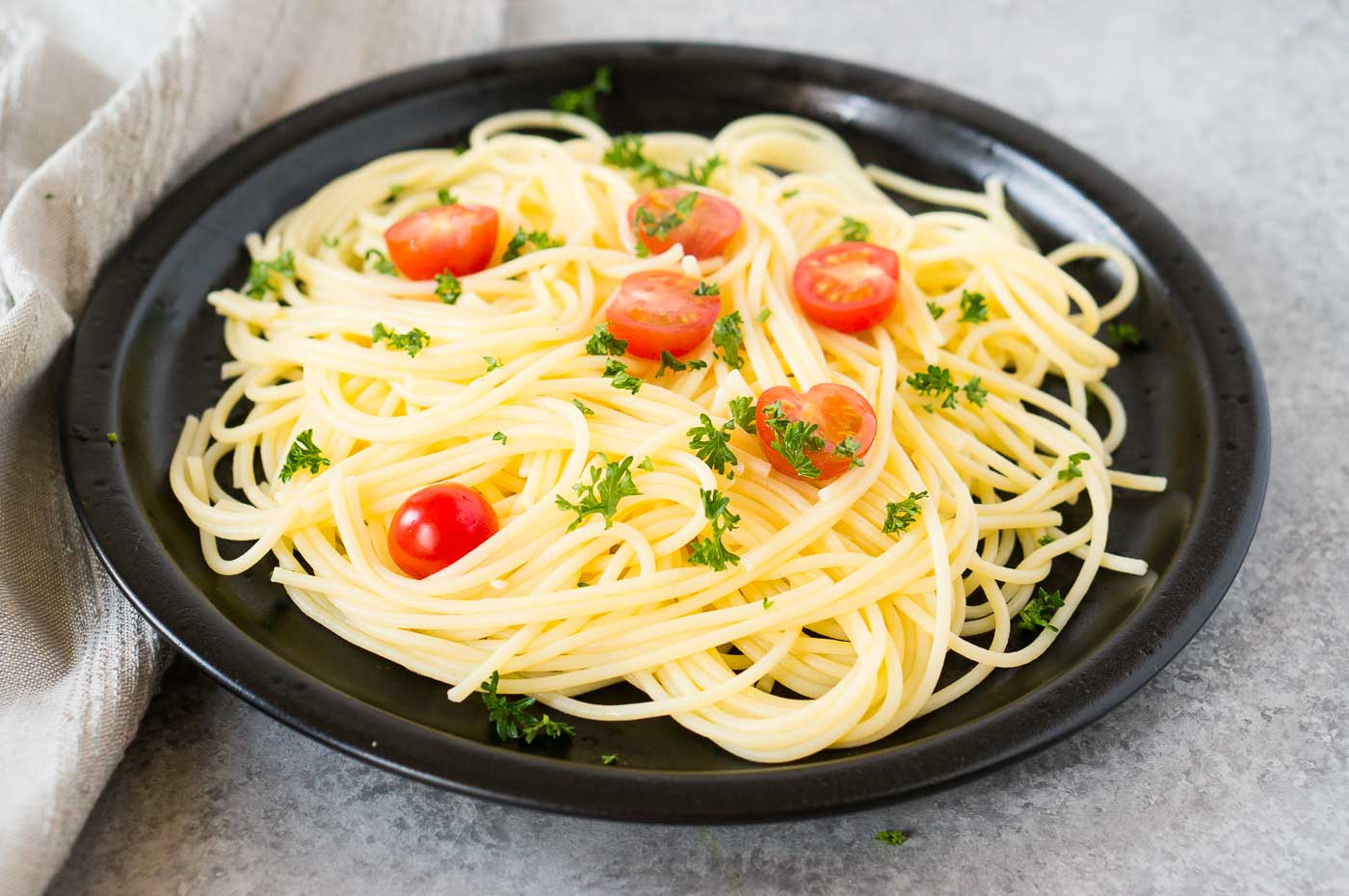
Ingredients
For a full ingredients list with measurements, check the recipe card below.
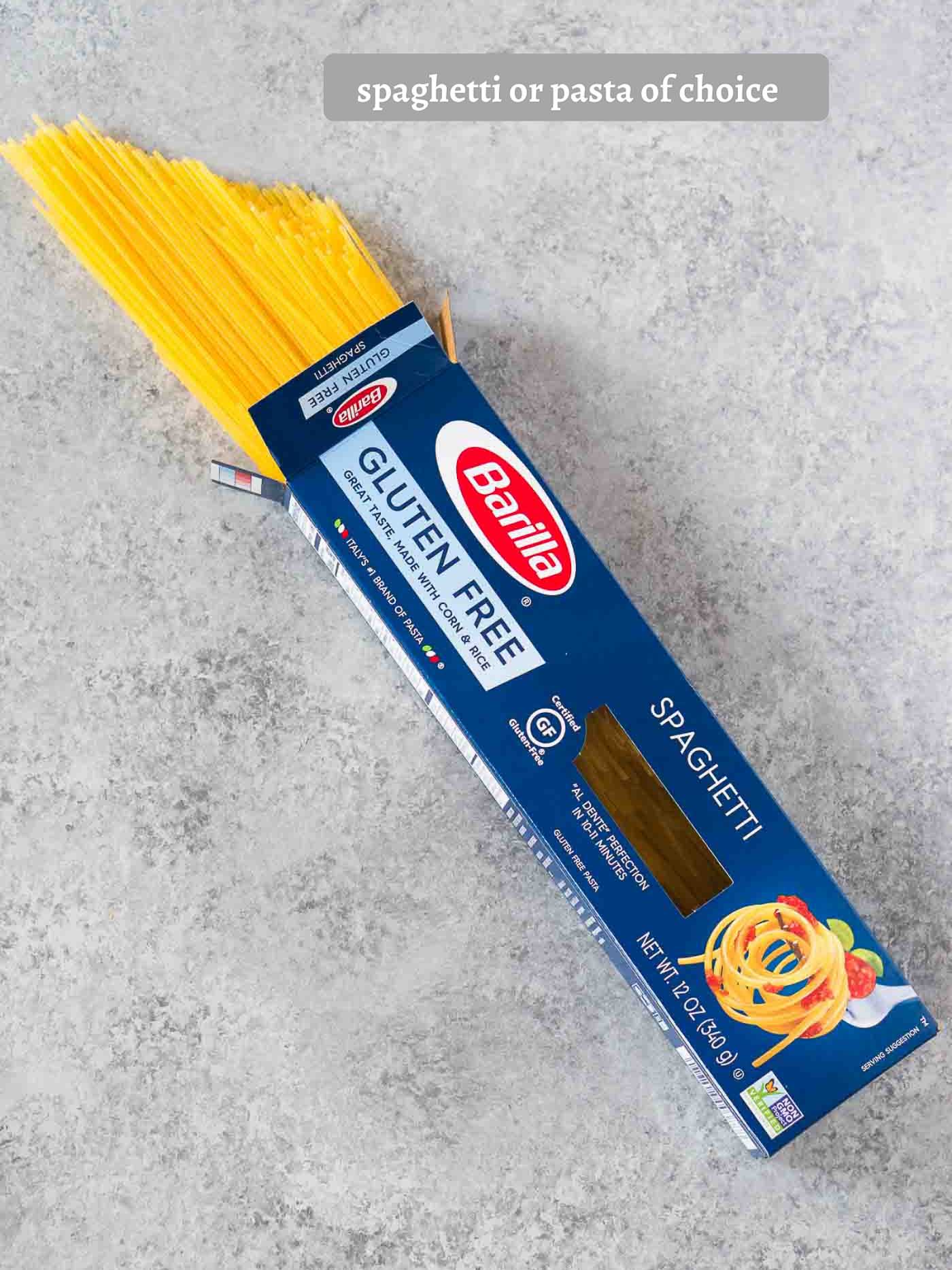
- Dried pasta: Most dried pasta shapes like fusilli, penne and bow tie will work great for this stovetop method.
- Salt: Salt is added to the water before adding the pasta. This helps to add flavor to the finished dish.
- Water: The water should be boiling before adding the pasta so that it cooks through evenly.
How To Cook Pasta Perfectly

- Bring a large pot of water to a full boil over high heat. Stir in the salt until dissolved.

- After the salt is dissolved, add the pasta to the boiling water, stir a few times to prevent the noodles from sticking together.

- Boil pasta according to package directions, stirring occasionally, until al dente, or for about 10 to 12 minutes. A couple of minutes before the suggested cooking time is up, taste the pasta. It’s al dente if it’s tender but still slightly firm in the middle.

- Reserve pasta water for the sauce if needed. Drain pasta, toss with sauce, and serve.
- For cold pasta salad, rinse pasta in a colander with cold water for 1 minute, stirring until cool.
TIPS FROM NELI’S KITCHEN
Expert Tips for the Perfect Pasta
Learning how to cook pasta isn’t difficult – just follow these tips and your pasta will come out perfect every time!
- The ideal water to pasta ratio is 5 quarts of water for every pound of pasta. It’s also the golden rule according to Italians. This allows the pasta to move as it boils so that it doesn’t stick together.
- Bring the water to a rolling boil before adding the spaghetti or pasta. If you start it in cold water it won’t cook through evenly, or the pasta will sit in water longer and loose it’s texture.
- Don’t skip the salt! My rule of thumb is 1 tablespoon of salt for every 5 quarts of water. This adds flavor to the pasta for the best tasting finished dish.
- Always stir the water when you first add the pasta.
- Taste the pasta at least two minutes before reaching the time printed on the packaging, and then again a minute later to make sure you drain it just when it is al dente.
- Cook the pasta al dente. If you overcook it, the pasta can become mushy as it will continue to cook once it’s drained, and again when added to a sauce.
- To help the sauce cling perfectly to the pasta, skip adding oil to the water or pasta after draining. Don’t rinse the pasta, and reserve some of the pasta water before you drain it to mix into the sauce (the starch in the pasta water helps the sauce stick to the pasta).
- If you use the pasta in a salad or a cold dish, rinse it with cool water to stop the cooking process and cool it down. You can also add a little bit of olive oil to prevent the pasta from sticking together.
Favorite Pasta Recipes
Once you have made your pasta, you’ll want some delicious recipes to incorporate it in! These are some of my favorites:
- Instant Pot Bolognese Sauce (serve it with spaghetti or pasta)
- Italian Meatballs (great served with pasta)
- Chicken Pesto Pasta
- Italian Pasta Salad
- Tuna Pasta Salad

Recipe FAQs
Al dente literally translates from Italian “to the tooth” meaning the pasta still has to have a bite or be slightly firm when bitten. The al dente pasta is tender but firm and chewy, and it has the best taste and texture. A couple of minutes before the suggested cooking time on the package, give the pasta a taste. If it’s tender enough to chew but still contains a bit of a bite, you’ve reached al dente. The sauce also sticks better to al dente pasta while it slides right off of full or over-cooked pasta.
Prolonged cooking of the pasta causes the release of starch in the cooking water therefore the loss of nutritional properties. Overcooked pasta also turns mushy and sticky.
A single serving size of pasta is typically about two ounces of dry pasta—amounting to about a cup of cooked pasta.
A pound of pasta (16 oz package) makes about 8 adult-size servings.
Cooked pasta should be drained and cooled before storing in an airtight container in the fridge. It will keep well for around 4 days. You can stir the cooked pasta into a hot sauce to heat it through to serve, or use it to make a pasta salad.
This method is for dried pasta, if you have fresh pasta like ravioli the cooking time is a lot quicker. Follow the instructions below for boiling and salting the water, but fresh pasta will only require around 3 minutes of cooking time depending on the thickness.
Traditional pasta is made with wheat flour, so it is not gluten-free. There are some great gluten-free dried pasta widely available if you do have a gluten intolerance. The cooking method remains the same, though the timings may differ.
Some great gluten-free pasta to try are: corn pasta, brown rice pasta, chickpea pasta, quinoa pasta, lentil pasta, and black bean pasta.
More Cooking Resources:
If you enjoyed this How To Cook Pasta Perfectly Guide or any other recipe on my blog, please leave a ⭐ star rating and let me know how it went in the 📝 comments below. Thanks for visiting!
Pin this now to find it later
Pin It
☝ Tap stars to rate
How To Cook Pasta
Save This Recipe
Enter your email and we’ll send the recipe directly to you!
By submitting this form, you consent to receive emails from Delicious Meets Healthy.
Ingredients
- 5 quarts water
- 1 Tablespoon kosher salt
- 1 pound dried pasta
Instructions
- Fill a large pot with water and bring water to a full boil over high heat. Stir in the salt until dissolved.
- After the salt is dissolved, add the pasta to the boiling water, stir a few times to prevent the noodles from sticking together.
- Boil pasta according to package directions, stirring occasionally, until al dente, or about 10 minutes. A couple of minutes before the suggested cooking time is up, taste the pasta. It's al dente if it's tender but still slightly firm in the middle.
- Reserve a small cup of cooking water to add to the sauce if needed. Drain over the sink and toss with desired sauce.
- If using the pasta in a salad, add to a colander and rinse with cold water for about 1 minute, stirring until cooled down.
Notes
- The ideal water to pasta ratio is 5 quarts of water for every pound of pasta. It’s also the golden rule according to Italians. This allows the pasta to move as it boils so that it doesn’t stick together.
- Bring the water to a rolling boil before adding the spaghetti or pasta. If you start it in cold water it won’t cook through evenly, or the pasta will sit in water longer and loose it’s texture.
- Don’t skip the salt! My rule of thumb is 1 tablespoon of salt for every 5 quarts of water. This adds flavor to the pasta for the best tasting finished dish.
- Always stir the water when you first add the pasta.
- Taste the pasta at least two minutes before reaching the time printed on the packaging, and then again a minute later to make sure you drain it just when it is al dente.
- Cook the pasta al dente. If you overcook it, the pasta can become mushy as it will continue to cook once it’s drained, and again when added to a sauce.
- To help the sauce cling perfectly to the pasta, skip adding oil to the water or pasta after draining. Don’t rinse the pasta, and reserve some of the pasta water before you drain it to mix into the sauce (the starch in the pasta water helps the sauce stick to the pasta).
- If you use the pasta in a salad or a cold dish, rinse it with cool water to stop the cooking process and cool it down. You can also add a little bit of olive oil to prevent the pasta from sticking together.
Nutrition
Nutrition Disclaimer: Nutritional values are estimates and may vary with ingredients, brands, and portion sizes. For accuracy, use your preferred nutrition calculator.
Disclaimer: The information provided in this recipe is for informational purposes only and should not be considered medical or nutritional advice. I am not a doctor or a dietitian. Always consult a qualified healthcare provider for personalized guidance regarding your diet or health. For more details, please read my full disclosure page.

